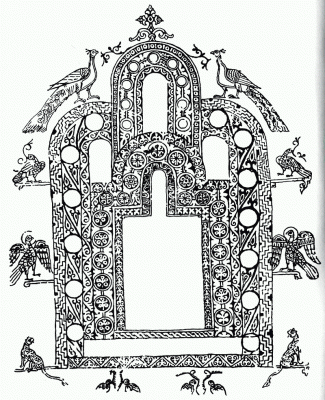Collections of Old Russian Manuscripts of Literary Content
The main collections of Old Russian manuscripts containing Old Russian literary works are in Moscow, Leningrad and Kiev. There are also fairly large collections in Novosibirsk, Pskov, Yaroslavl, Vladimir, Rostov, Kostroma and some other towns. Small numbers of Old Russian manuscripts are scattered about in various museums of local lore, university libraries and archives, and are also in the private possession of book collectors, Old Believers and their descendants, and others.

Illumination from the Gospel written for the Yuriev Monastery (Novgorod). C. 1120. History Museum, Moscow
In Moscow the main, very rich collections are in the Lenin State Library of the USSR, the StateHistoryMuseum, the Central State Archives of Old Documents, and the library of MoscowStateUniversity. In Leningrad the main collections are in the Saltykov-Shchedrin State Public Library, the Library of the Academy of Sciences of the USSR, the Central State Historical Archives of the USSR, the Leningrad Department of the Institute of History of the Academy of Sciences of the USSR, and the Malyshev Archives of the Institute of Russian Literature of the Academy of Sciences of the USSR. In Novosibirsk there are manuscripts in the Scientific Library and in Pskov in the Archives of the Pskov Museum of Art and Architecture. There are also a relatively small number of Old Russian manuscripts abroad: in Bulgaria, Yugoslavia, Mount Athos, the BritishMuseum in London, the Bibliotheque Nationale in Paris, the Vatican Library, Oslo, etc.
In each of the main repositories mentioned the manuscripts form part of collections that belonged to monasteries, scholars, book collectors, etc. Thus, for example, the Saltykov-Shchedrin State Public Library has the collection of the historian Mikhail Pogodin who purchased Pavel Stroyev’s vast collection and also collected manuscripts independently; there are also manuscript collections from the libraries of the Solovetsky Monastery, the White Lake Monastery of St Cyril, and so on. The Malyshev Archives manuscripts are arranged according to the collectors from whom they were acquired or who donated them, and also according to the places where they were found by special archaeographic expeditions. There is the Karelian collection (manuscripts found in the Karelian ASSR), the Ust-Tsilma collection and others. The StateHistoryMuseum has the collection of Alexei Uvarov. Uvarov not only collected manuscripts himself, but also acquired a large collection from the merchant Tsarsky. Both collections have separate printed scientific descriptions. This should be borne in mind, for information about manuscripts printed in one scientific description may be repeated and amplified in another. There is an extensive literature of scientific descriptions of collections in the major manuscript repositories. These scientific descriptions have been compiled and published at different times. The manuscripts mentioned in them have suffered different fates. Anyone making a study of Old Russian manuscripts must at least be familiar with the history of the major collections of these manuscripts. The major manuscript archives usually have an information section where scientific descriptions can be consulted. Scientific descriptions help the researcher to find literary works of interest to him. Apart from printed scientific descriptions there are handwritten descriptions or card indexes of varying degrees of comprehensiveness and accuracy. There are also guides to manuscript collections in the archives in question and a brief description of their contents. The researcher should be proficient at consulting these descriptions and guides and have a clear idea of their merits and defects.
 History of Russian Literature
History of Russian Literature
